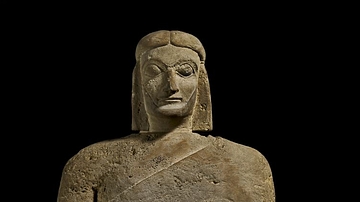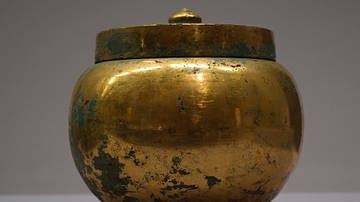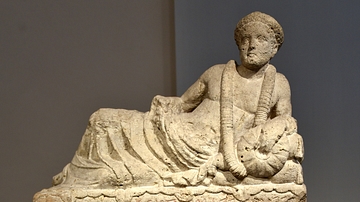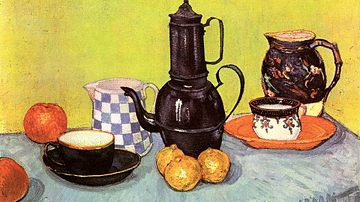Illustration
Roman blue-glass cinerary urn, from Luguvalium (Botchergate, Carlisle), 1st century CE.
Carlisle Cathedral.
Burning the body after death and keeping the bones and ashes in the cineraria (funerary urns) was a deeply rooted cultural tradition in the Roman societies inherited from their Etruscan ancestors. Roman urns could have a curvy jar shape typical for this sort of vessel across ancient cultures. However, in a distinction from classical Greece, they could also appear in a rectangular box shape, functioning as an ornamental sarcophagus. Diversity was also present in their material ranging from various wooden boxes to terracotta or marble vessels to white or blue glass jars. Blown glass jars were distinctly popular, and despite their relative fragility, they compose a notable number of archaeological finds particularly from parts of Western Europe, including Belgium, Britain, France, Germany, and Italy.
The blue-glass cinerarium in the treasury of Carlisle Cathedral is among the invaluable artefacts unearthed in Botchergate out of the old walls of Luguvalium, the Roman forerunner city of today’s Carlisle in Cumbria, north of England, not far from Hadrian's Wall. Reassembled from broken pieces, the urn implies simplicity combined with a characteristic distinction expressed in a series of strong, upright lines, depressed all around its circumference. Like many of its peers, the urn was possibly crowned with a glass lid, which is now lost. The tradition of keeping human remains in funerary urns remained widespread in the Roman Empire until the 4th century CE, when Christianity became prominent and replaced this practice with the interment.
About the Author
External Links
Cite This Work
APA Style
Choubineh, N. (2024, November 13). Roman Blue-Glass Cinerary Urn from Luguvalium. World History Encyclopedia. Retrieved from https://www.worldhistory.org/image/19644/roman-blue-glass-cinerary-urn-from-luguvalium/
Chicago Style
Choubineh, Nathalie. "Roman Blue-Glass Cinerary Urn from Luguvalium." World History Encyclopedia. Last modified November 13, 2024. https://www.worldhistory.org/image/19644/roman-blue-glass-cinerary-urn-from-luguvalium/.
MLA Style
Choubineh, Nathalie. "Roman Blue-Glass Cinerary Urn from Luguvalium." World History Encyclopedia. World History Encyclopedia, 13 Nov 2024. Web. 16 Apr 2025.








